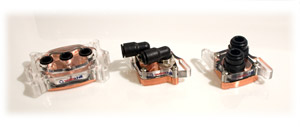Asetek Waterchill XTernal External Water Cooling Kit
Waterblocks
The Waterblocks
As mentioned before, the monolithic Xternal unit is only a piece of the puzzle for the entire kit. The Xternal unit pumps and cools the water which flows through the system, but the water must be connected to individual water blocks on heat producing components to function. Asetek bundles three separate water blocks with this kit, one for your CPU, one for your GPU, and one for your chipset.
The water block that was bundled with our kit is the Asetek Antarctica CPU01 unit, which is compatible with Socket-754/939/940 based AMD systems and Socket-478 based Intel systems. The block which we used was not compatible with Socket-775 systems by default, but includes an adapter which can be used to make the block compliant with Socket-775 systems.
The water block is a copper based unit which has three 3.8" plug connectors on top, and is (according to Asetek) capable of handling CPU's at power levels of 200W. Top of the line Athlon64 FX-62 processors are at 125W currently, whereas top Core 2 Duo systems are at 80W, so you should have plenty of breathing room here. Water flows on to the center of the block to the sides, where it is pumped away to the next component in the water chain. Installation was a breeze on our Socket-939 test system, although the motherboard must be removed from the chassis for installation. Asetek has a terrific twist-screw tightening system which provides secure contact without letting you over tighten the unit.
After water runs through the water block, the next step in the chain is the chipset, which is cooled by the Asetek NB01/P1 chipset cooler. This copper-based unit is much smaller, but still provides more than enough cooling power for any modern chipset. The mounting system is designed for chipset coolers which are screw-based through the motherboard, whereas many modern Intel boards do not use this type of mounting mechanism. In addition, a lot of new motherboards use heatpipe-based cooling systems to cool the chipset and the motherboard VRM's, which the Asetek cooler obviously couldn't cool. This component is likely to have the most incompatibility issues, but if the unit isn't compatible with your motherboard, it can simply be left out of the cooling loop - you do not specifically need to install this component.
The third water block is the VGA cooler, dubbed the VGA01/P1, which is compatible with both modern nVidia and ATI graphics cards. The unit is also copper based, but features 90 degree tilted hose mounts, to save some space for other expansion cards in the system. When mounted, the GPU cooler will occupy two case slots. If you purchased another GPU water block and had an SLI/Crossfire motherboard which had two expansion slots between the PCI Express x16 slots, it could be possible to run a water-cooled multi-GPU configuration with this hardware, but Asetek does not recommend such configurations. One should also note that the VGA cooler only cools the GPU, but does not cool the hot-running DDR memory modules on modern cards. We think it would be appropriate for Asetek to provide a set of memory heatsinks, as running a modern graphics card without DDR heatsinks will un-do all the good which having a water-cooled GPU will help with. Installation of this component is relatively painless, and the hardest issue will likely be removing the stock cooler from your graphics card.
Since all of these components use standard 3/8" water tubing, it's also possible to purchase additional water blocks which this kit doesn't include by default. For example, Asetek sells a water-based hard drive cooling system which could hook up to this set up quite easily. However, the more components you add to the water cooling system, the less effective it becomes, as flow rates drop and more components are adding heat to the water, the fans have to work harder to get rid of this extra heat.
Once all the waterblocks are installed on their varying components, one simply has to connect the correct tubing between the Xternal unit and all of the blocks. Asetek includes a three meter hose which has to be manually cut to fit the lengths of your individual system. If you've never worked with a water cooling kit before, this can be scary, but the whole process is really quite simple. Measuring, cutting, and connecting the cables took about ten minutes altogether. Asetek uses high-quality connectors, so once the hose is connected, it's quite difficult to remove unless you're directly pulling on the tube. When moving around the blocks, the hoses won't come loose or leak. We would, however, have liked to see some quick release connectors on the back of the Xternal unit, to allow you to move the unit if need be (i.e, the Zalman Reserator Series 2 units have these). While the system is flexible, once you get it up and running, you're not going to want to make any major modifications to it.










